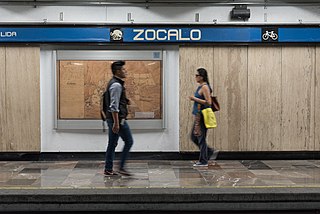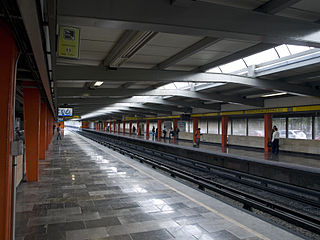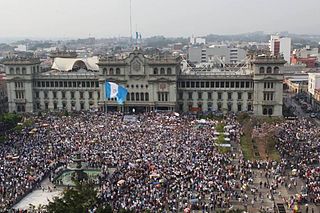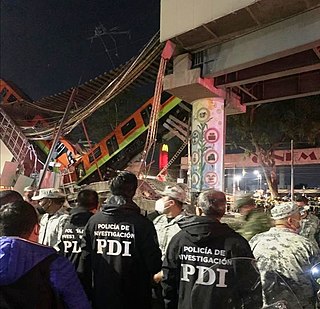Related Research Articles

Quintana Roo, officially the Free and Sovereign State of Quintana Roo, is one of the 32 states which compose the federal entities of Mexico. It is divided into 11 municipalities and its capital city is Chetumal.

Cancún is a city in southeast Mexico on the northeast coast of the Yucatán Peninsula in the Mexican state of Quintana Roo. It is a significant tourist destination in Mexico and the seat of the municipality of Benito Juárez. The city is on the Caribbean Sea and is one of Mexico's easternmost points.

Zócalo/Tenochtitlan is a station of the Mexico City Metro in the historic center of the city, in the Cuauhtémoc borough. It is an underground station with two side platforms, served by Line 2. It lies between Allende and Pino Suárez stations. The station's pictogram features the coat of arms of Mexico and it receives its name from the Plaza de la Constitución, commonly known as Zócalo, Mexico City's main square located above the station. The station was opened on 14 September 1970, on the first day of the service Tasqueña–Tacuba.
Augusto Monterroso Bonilla was a Honduran writer who adopted Guatemalan nationality, known for the ironical and humorous style of his short stories. He is considered an important figure in the Latin American "Boom" generation, and received several awards, including the Prince of Asturias Award in Literature (2000), Miguel Ángel Asturias National Prize in Literature (1997), and Juan Rulfo Award (1996).

Consulado is a transfer station of the Mexico City Metro in Gustavo A. Madero and Venustiano Carranza, Mexico City. It is a combined elevated and at-grade station, along Lines 4 and 5. Consulado is located between Bondojito and Canal del Norte stations on Line 4, and between Valle Gómez and Eduardo Molina stations on Line 5. It serves the colonias of 7 de Noviembre, 20 de Noviembre, Felipe Ángeles, and Mártires de Río Blanco.

Instituto del Petróleo is a Mexico City Metro transfer station in Gustavo A. Madero, Mexico City. It is a combined underground and at-grade station with two side platforms each, along Lines 5 and 6. Instituto del Petróleo is located between Politécnico and Autobuses del Norte stations on Line 5, and between Vallejo and Lindavista stations on Line 6. It serves the colonias of Valle del Tepeyac, San Bartolo Atepehuacan, and Nueva Industrial. The station's pictogram depicts an oil derrick, and its name is on account of its proximity to the Mexican Petroleum Institute headquarters.

Estadio Regional de Antofagasta, officially Estadio Regional Bicentenario Calvo y Bascuñan de Antofagasta, is a sport facilities complex located in Antofagasta, Chile. The municipality of Antofagasta is the owner of the building and it used to host sports events such as cultural events and entertainment events. The complex is composed of the Main Stadium who is use made for most important events. The secondary fields, 1, 2, 3 and 4, are used for training sessions. The Field 5 is used to secondary events, with football pitch dimensions and counts with a Baseball field where are made the regional tournaments of this sport.

Misterios is a Mexico City Metro station in the limits of Cuauhtémoc and Gustavo A. Madero, in Mexico City. It is an underground station with two side platforms, served by Line 5, between La Raza and Valle Gómez stations. Misterios station serves the colonias of Peralvillo and Vallejo.

Valle Gómez is a Mexico City Metro station in the limits of Gustavo A. Madero and Venustiano Carranza, in Mexico City. It is an underground station with two side platforms, served by Line 5, between Misterios and Consulado stations. Valle Gómez station serves the colonias of 7 de Noviembre and Valle Gómez; the station receives its name from the latter. The station's pictogram features an agave plant. Valle Gómez was opened on 1 July 1982, on the first day of the La Raza–Pantitlán service. In 2019, the station had an average daily ridership of 4,416 passengers, making it the 190th busiest station in the network and the least busy of the line.

Tláhuac is a station of the Mexico City Metro in the colonia of El Triángulo, Tláhuac, Mexico City. It is an at-grade station with two island platforms that serves as the southern terminus of Line 12. The station's pictogram features the glyph of Tláhuac. It is followed by Tlaltenco station, in the same borough. The station was opened on 30 October 2012, on the first day of the service Tláhuac–Mixcoac.

Mexico City Metro Line B is one of the twelve metro lines operating in Mexico City, Mexico. It has 21 stations and a total length of 23.722 km, 20.278 km service the line while the rest are used for maneuvers.

Bernardo Quintana Arrioja was a Mexican civil engineer who contributed to his country's infrastructure during the second part of the twentieth century. Bernardo Quintana studied civil engineering at the National Autonomous University of Mexico (UNAM) and made important contributions to engineering by developing, adopting and spreading innovative technologies in the construction of large civil projects. He contributed a generation infrastructure projects in a number of areas of Mexico.

Mexibús is a bus rapid transit (BRT) system that is located in the Greater Mexico City part of the State of Mexico, which surrounds Mexico City proper through 97 stations.
Lucrecia Méndez de Penedo is a Guatemalan university professor, essayist, researcher, and literary and art critic. She has been instrumental in rescuing some of Guatemala's literary heritage from obscurity.

La Línea corruption case began in Guatemala on April 16, 2015, when the International Commission against Impunity in Guatemala and State prosecutors accused a number of politicians in the administration of President Otto Pérez Molina of setting up a customs corruption ring with the help of high-ranking officials in the tax and customs administration. Several demonstrations ensued, calling for the resignation of Pérez Molina and his vice-president Roxana Baldetti. Among the accused were the retired captain Juan Carlos Monzón, and the directors of the Tax Administration Superintendency or Superintendencia de Administración Tributaria, (SAT), an entity analogous to the US Internal Revenue Service. Baldetti resigned in early May, to the joy of thousands of demonstrators.
The Apertura 2017 Copa MX was the 78th staging of the Copa MX, the 50th staging in the professional era and is the eleventh tournament played since the 1996–97 edition.

The Toluca–Mexico City commuter rail project is a 57.7 km (35.9 mi) commuter rail line currently under construction. Also known as Interurban Train Mexico City–Toluca, the passenger railway line will connect the cities of Toluca and Mexico City. The project was announced by President Enrique Peña Nieto on 1 December 2012. Construction began in July 2014. As of October 2020, it was estimated to open in 2023.

The Sistema de Transporte Público Cablebús, simply branded as Cablebús, is an aerial lift line in Gustavo A. Madero and Iztapalapa, Mexico City. It is operated by Servicio de Transportes Eléctricos, the agency responsible for the operation of all trolleybus and light rail services in Mexico City. Line 1 was officially inaugurated on 11 July 2021, going from Indios Verdes metro station to the northern neighborhoods of Gustavo A. Madero. Line 2 runs from Constitución de 1917 metro station to Santa Marta metro station in the southeast of the city.

The Conalep Ing. Bernardo Quintana Arrioja is a high school campus in Mexico. It was named in this way in honor of the Mexican civil engineer, Bernardo Quintana. It belongs to the campuses that are part of the National College of Professional Technical Education in the State of Mexico and its located in the municipality of Cuautitlán Izcalli.

On 3 May 2021, at 22:25 CDT (UTC−5), a girder supporting an overpass carrying Line 12 of the Mexico City Metro collapsed beneath a passing train in the borough of Tláhuac. The overpass and the last two cars of the train fell onto Tláhuac Avenue near Olivos station, killing 26 people and injuring 79 others. It was the Metro's deadliest accident in almost 50 years.
References
- 1 2 "Empresas ICA SAB de CV". Reuters . Retrieved 5 May 2021.
- 1 2 "Nuestra Historia". ICA. Archived from the original on 2013-06-29. Retrieved 5 May 2021.
- 1 2 3 4 5 6 7 8 9 10 11 12 13 14 "Entérate. ¿Cuáles son las obras más emblematicas de la constructora ICA?". El Universal (in Spanish). 18 June 2018. Retrieved 13 July 2021.
- 1 2 Quintana, Bernardo (2005). "Ciencia y Tecnología: La Fuerza del Agua". Revista UNAM. National Autonomous University of Mexico . Retrieved 13 July 2021.
- 1 2 3 "9 obras de ICA, constructora de Línea 12". Expansión (in Spanish). 14 March 2014. Retrieved 13 July 2021.
- ↑ "El desplome de la Línea 12 fue una advertencia para el Tren Maya, dice Fonatur". Expansión (in Spanish). 18 June 2021. Retrieved 13 July 2021.